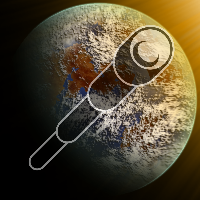Mechanism
A ward is a self-replicating biotechnological system which augments the body's natural immune system. The system has limited swarm intelligence but is primarily controlled by the central node: a bio-microchip typically inserted in the soft tissue of the neck during infancy. Wards operate using a very large, complex, and individually-tailored set of instructions called "ward protocols," which are continuously updated and modified by both the system itself and licensed physicians over the course of the user's life.
Central Node
The central node stores the primary intelligence and database of the system and directs the swarm to enact procedures as needed. It is powered by the same metabolic processes that power cells in the body, relying primarily on glucose-oxygen reactions. The central node integrates with the nervous system to synchronize with natural immune responses and communicate with the distributed roaming units. This also allows a limited degree of manual thought control.
Roaming Units
Individual roaming units are artificial cells designed to mimic endemic immune cells, particularly by hosting the appropriate recognition proteins on their surfaces. These units are equipped with configurable molecular production complexes, gene therapy systems, and external manipulator and propulsion mechanisms, all connected to nanoscopic radio transceivers to allow the control node to direct their actions. In this way, they are able to navigate anywhere in the body.
Functionality
The invention of wards effectively eliminated a whole host of complex medical issues that often posed significant mortality risks, such as cancer, cardiopulmonary failures, neurodegenerative diseases, and genetic disorders.
Senescence has been significantly reduced as well: wards allow for constant monitoring and upkeep of bodily systems that typically wear down with age, including musculature, joints, neurons, and even
telomeres.
Biological Barrier
A particularly useful feature of a ward is that it actively prevents the internal microbiome of the user from being contaminated by the microbiome of the local environment, and vice versa. While it is broadly true that most
biological systems that arose from different
abiogenetic origins do not directly interact with each other, there remains the distinct possibility that certain nonnative organisms will outcompete native ones in processing raw resources, thereby undermining the trophic web and local ecology. This can happen in either direction, and for a long time cross-species contact had to be conducted with both parties in
isolation suits. The application of ward protocols to this problem was revolutionary, allowing
sophonts from separate worlds to interact freely and share living space without risk of contamination.
We've Got Radio-Active Blood?
Roaming ward units are in constant communication, using each other as radio relays around the body. This radio chatter is very weak and typically is not detectable beyond the skin, but is strongest in the blood. An unusual side effect of this is the fact that open wounds are unusually radio-bright thanks to thousands of microscopic bio-bots blipping at each other over the 100-MHz radio band. In short: don't stand next to the radio telescope if you are bleeding!
Customization
Ward central nodes are able to interface with secure external devices, allowing the user to work with licensed physicians to customize their ward protocols. Each individual has a specific set of bodily norms that will differ from person to person, and maintaining the information on that baseline is a lifelong project as bodies naturally change over time. The most common element of customization is artificial hormone regulation, allowing users to control their reproductive cycle or even vary their phenotypical expression with relative ease.
Limitations
Wards do not have the ability to protect against or significantly repair major physical injuries like lost limbs, broken bones, and acute organ damage. While they can help accelerate the healing process of these sorts of injuries, such things still need to heal over periods of days to weeks. Additionally, certain external conditions (such as extreme electromagnetic fields) can damage the system itself. Ward nodes are shielded against radiation and electromagnetic disruption, but only up to a point. Damage to the system triggers the fail-safe deactivation protocol and usually requires a full replacement of the central node and re-synchronization with the roaming units --a process that can take up to a month.






I really like the concept of pinnacle technologies, but the thing that stood out most was the info in the radioactive infobox. Don't stand near the radio telescope indeed!
Thank you!! I thought it was amusing that getting a mere paper cut near sensitive radio equipment could cause a peryton, hehe. I do plan to expound on what exactly makes a "pinnacle technology" in the near future as part of my primer article revisions, so stay tuned! :3